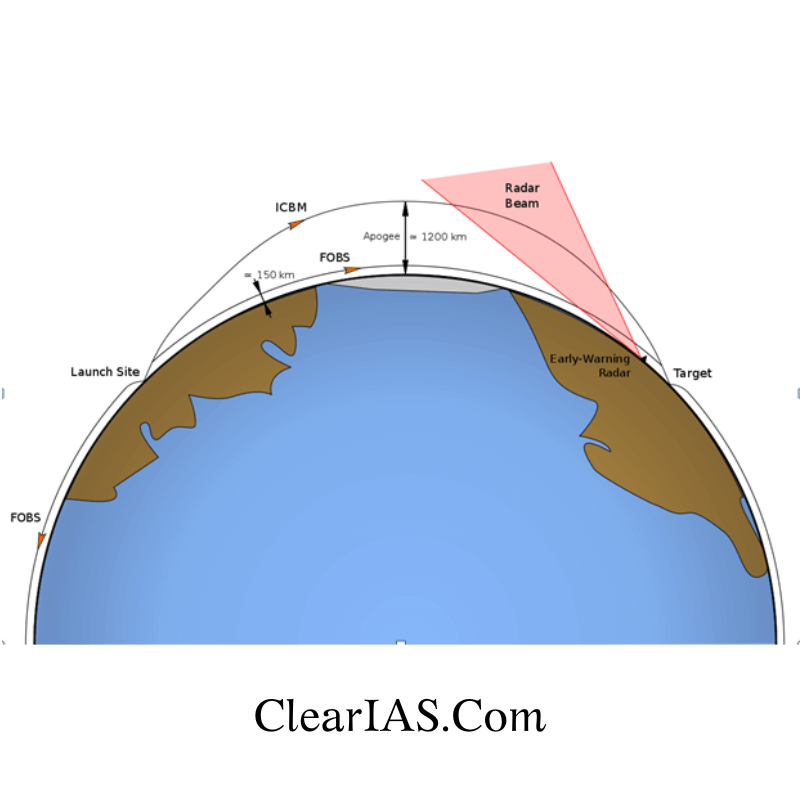
Did you hear about the Fractional Orbital Bombardment System? What are the concerns associated with it for India? Read the following article to know more about this.
Between the 1950s and 1960s, the US and USSR were racing each other in a global arms race and were actively searching for more efficient methods to knock down each other. Both are equipped with nuclear capabilities, nuclear submarines, aircraft capable of carrying heavier nuclear bombs, and also intercontinental ballistic missiles.
In the early 1960s, a revolutionary idea emerged in the Soviet Union to launch nuclear weapons into the low earth orbit and then deorbit (to go out of orbit) at the right time towards its target destination (US cities). This system is known as the fractional orbital bombardment system (FOBS).
FOBS is the system that is used to launch nuclear warheads from space which uses low earth orbit for its target destination.
Salient features of FOBS

The Fractional Orbital Bombardment System (FOBS) was a concept related to space-based nuclear weapons delivery. It originated during the Cold War and was associated with the Soviet Union. The idea behind FOBS was to place nuclear warheads in orbit around the Earth and deorbit them to strike targets on the Earth’s surface.
Unlike traditional intercontinental ballistic missiles (ICBMs) that follow a predictable ballistic trajectory, FOBS weapons could approach their targets from unexpected directions, making them potentially more challenging to defend against.
- A most important feature is its capability to attack from any direction and hide the target destination till the payload is dropped.
- It has no fixed trajectory as it can use thrusters to change This is a serious problem for the US as its defence system relies on the detection of an ICBM launch which follows an arcing trajectory. Also, most of North America’s early warning systems are pointed towards the North Pole but the FOBS targets the South Pole which will again make it the nation to early detection of FOBS missiles.
- It has no range limit and can be targeted at any point on the earth.
From the above fig, you can observe that an ICBM (Intercontinental ballistic missile) travels in a really big arc such that its top going from the Soviet Union to the US is about 1300km above the Earth whereas FOBS enters at a much lower orbit such that it can arrive the US about 10 minutes quicker.
Why did FOBS stay back even after the outer space treaty?
FOBS was considered a destabilizing element of strategic arms control because it created difficulties in early warning systems and led to concerns about the potential for a surprise nuclear attack.
The Outer Space Treaty was signed in 1967, which prohibits signatories from putting nuclear weapons in the orbit around the earth.
The Soviet Union claimed that FOBS took a partial orbit and didn’t make a full orbit. So Soviets named the system “fractional orbital bombardment system”.
There is a claim from space lawyers that, since the orbit is a condition and not an altitude, fractional orbits are still orbits and hence if the Soviet Union launched it with a real nuclear weapon they would have violated the treaty.
SALT II agreement
Strategic Arms Limitation Talks (SALT II) agreement was signed between the Soviet Union and the US. This agreement prohibited the deployment of FOBS. However, the US did not ratify it in response to the invasion of Afghanistan by the Soviet Union. Soviet Union decommissioned FOBS in 1983.
Recently China tested a new hypersonic weapon system i.e. an orbital bombardment system which comes out as unwelcome news as it may be yet another step for a dangerous arms race.
Concerns for India
Even though Chinese FOBS is not necessarily India-specific, its FOB capability is yet another challenge that India needs to be prepared for at the earliest.
Things that can be done:
- India has to considerably enhance its nuclear capability.
- More investment in underwater vehicles and long-range cruise missiles which use nuclear energy as their primary fuel.
- India needs to drastically increase the number of military satellites that it operates in LEO.
- India has to focus on developing space planes that can be used to deliver weapons from space.
Again the world is seen to be entering into a nuclear arms race as the US is panicked by China’s new test which made the world more chaotic. Even though it is a potent weapon, FOBS can be seen as a ‘first strike’ weapon or a weapon intended to limit an opponent’s ability to respond.
Previous year question
Q. Which one of the following statements best reflects the idea behind the “Fractional Orbital Bombardment System” often talked about in media? (Prelims 2022)
- (a) A hypersonic missile is launched into space to counter the asteroid approaching the Earth and explode it in space.
- (b) A spacecraft lands on another planet after making several orbital motions.
- (c) A missile is put into a stable orbit around the Earth and deorbits over a target on the earth.
- (d) A spacecraft moves along a comet at the same speed and places a probe on its surface.
Answer:- (c)
Article written by:- Krishnapriya JR






Leave a Reply